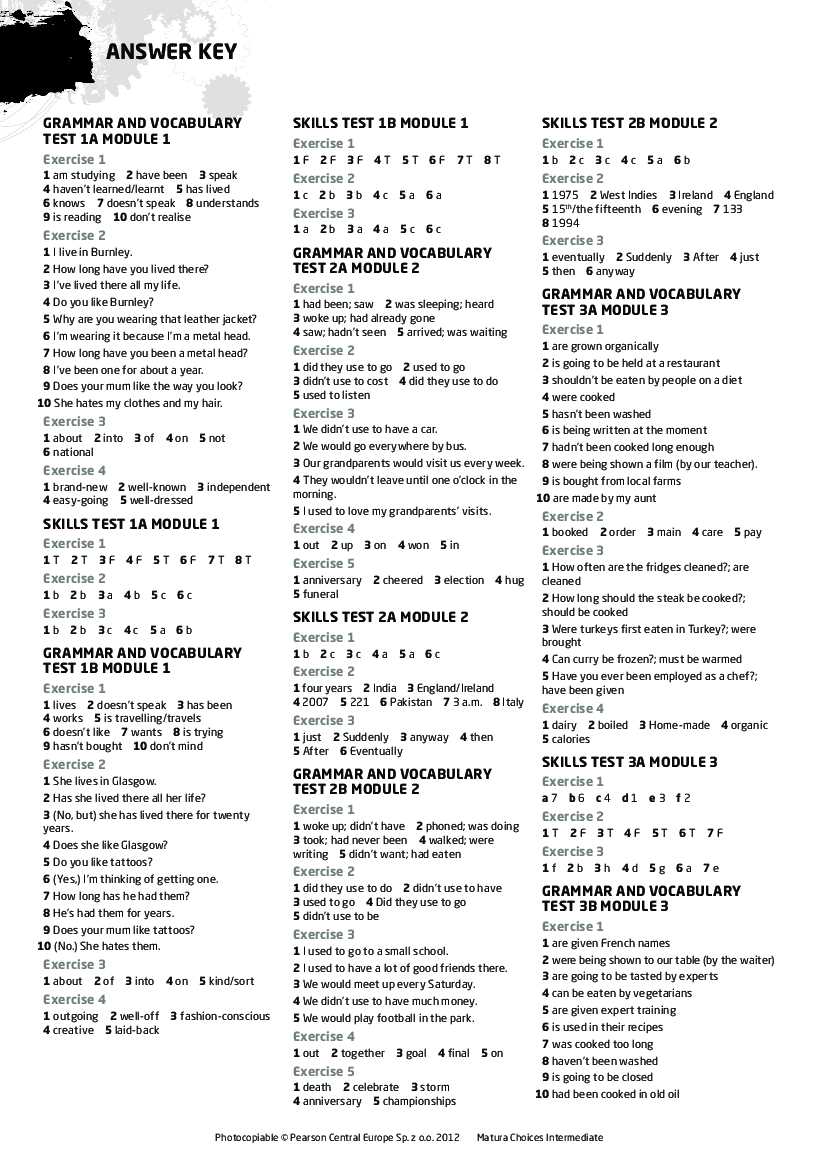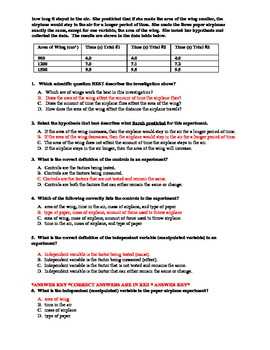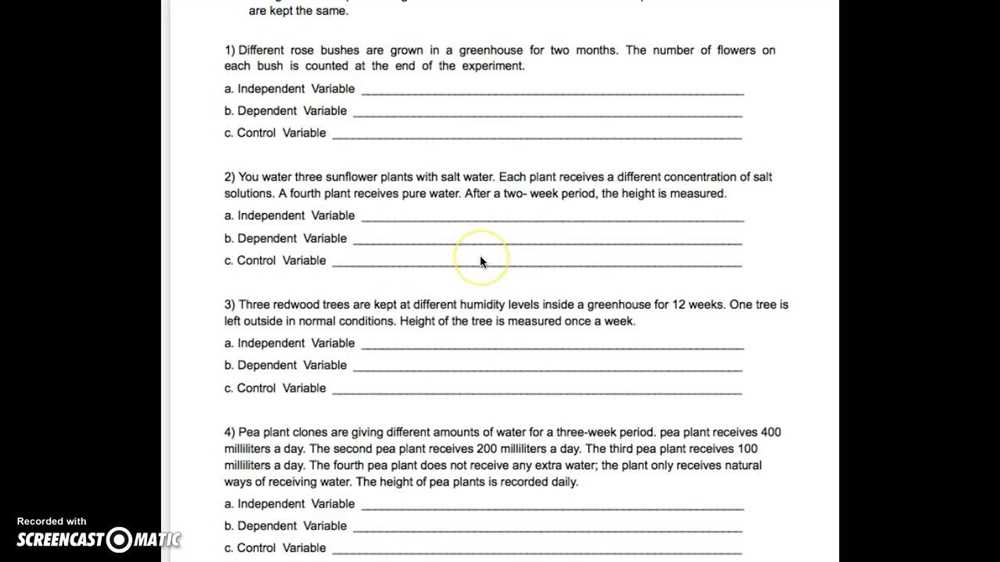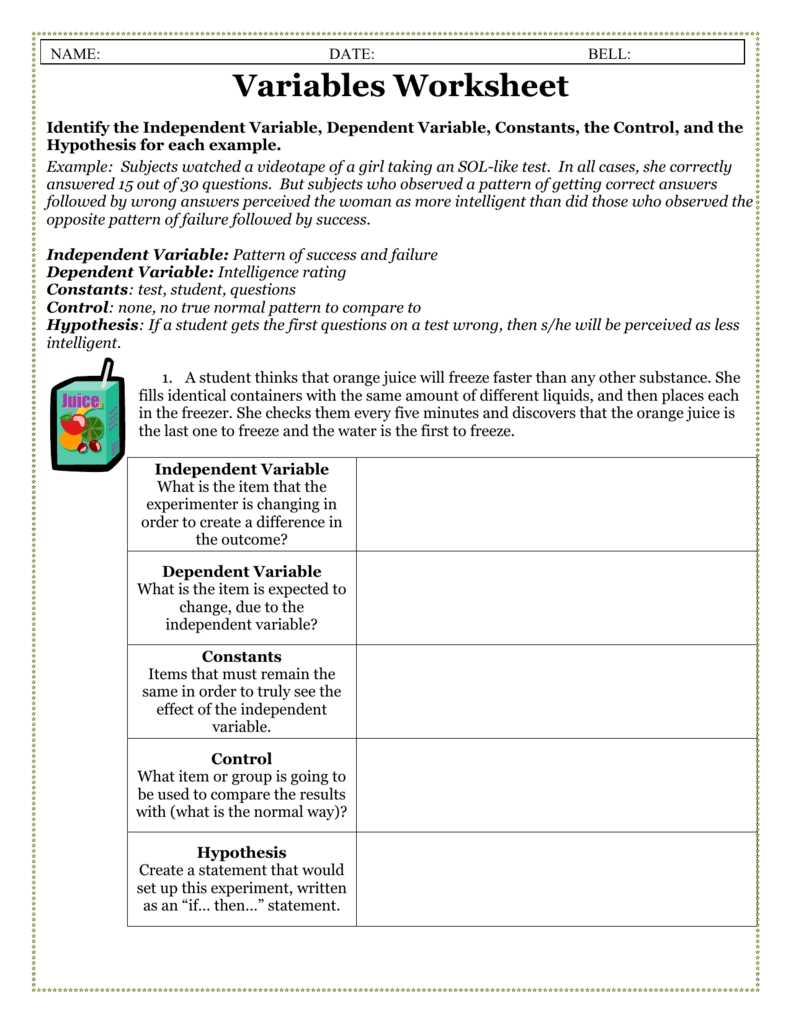
When conducting experiments, it is important to identify and control the variables involved in the study. The outcome of an experiment can be influenced by several variables, including the independent variable, dependent variable, control variables, and extraneous variables. Understanding and managing these variables is crucial to ensure the accuracy and reliability of the experimental results.
The independent variable is the variable that is deliberately manipulated or changed by the researcher. It is the factor that the researcher believes will have an effect on the dependent variable. In an experiment testing the effect of temperature on plant growth, for example, the independent variable would be the temperature. The researcher would manipulate this variable by exposing the plants to different temperature conditions.
The dependent variable, on the other hand, is the variable that is being measured or observed in the experiment. It is the outcome or response variable that is expected to be influenced by the independent variable. In the plant growth experiment, the dependent variable would be the growth rate or height of the plants. The researcher would measure this variable to determine the effect of temperature on plant growth.
Control variables are factors in an experiment that are kept constant or unchanged in order to ensure that any observed effects can be attributed to the independent variable. These variables include all other factors that could potentially influence the dependent variable but are not being tested as part of the experiment. In the plant growth experiment, control variables might include factors such as soil type, amount of water, and sunlight exposure. By keeping these variables constant, the researcher can isolate the effect of temperature on plant growth.
Finally, extraneous variables are any variables other than the independent and dependent variables that can potentially affect the outcome of the experiment. These variables can introduce unwanted variability and confound the results. It is important for the researcher to identify and control for these variables as much as possible. In the plant growth experiment, extraneous variables might include factors like humidity, air quality, or presence of pests. While it may not be possible to eliminate all extraneous variables, the researcher can minimize their impact by conducting the experiment in controlled conditions.
Experimental Variables Answer Key: Understanding the Basics

In the field of experimental science, variables play a crucial role in designing and conducting experiments. Understanding the basics of experimental variables is essential for researchers to draw accurate conclusions and make valid claims based on their findings. By manipulating variables and controlling their effects, scientists can establish cause-and-effect relationships and explore the relationships between different factors in their experiments.
In an experiment, there are typically three types of variables:
- Independent Variable: This is the variable that is manipulated or changed by the researchers. It is the factor that the researchers believe will have an effect on the outcome of the experiment. For example, in a study investigating the effects of temperature on plant growth, the independent variable would be the temperature levels.
- Dependent Variable: This is the variable that is measured or observed as a result of the changes in the independent variable. It is the outcome or response that the researchers are interested in studying. In the plant growth experiment, the dependent variable would be the height or biomass of the plants.
- Control Variable: This is the variable that is kept constant or unchanged throughout the experiment. Its purpose is to eliminate or minimize the effects of other factors that may influence the outcome. Control variables help ensure that any differences observed in the dependent variable can be attributed to the changes in the independent variable. In the plant growth experiment, control variables could include factors such as the type of soil, amount of water, and light exposure.
By identifying and carefully controlling these variables, researchers can accurately analyze and interpret their experimental results. It is important to note that while these three types of variables are commonly used, there may be additional variables that need to be considered depending on the specific experiment and research question. Understanding and managing variables effectively is fundamental to the scientific process and the advancement of knowledge in various scientific disciplines.
The Importance of Experimental Variables in Scientific Research
Experimental variables play a crucial role in scientific research as they allow researchers to systematically investigate the cause-and-effect relationships between different factors. By manipulating and controlling various variables, scientists can gather reliable and valid data to support their hypotheses and draw meaningful conclusions. By carefully selecting and controlling experimental variables, researchers can minimize the influence of confounding factors and ensure that their findings are accurate and applicable to real-world situations.
Independent variables are one of the key types of experimental variables. These are the factors that the researcher intentionally manipulates or changes in order to examine their effect on the dependent variable. For example, in a study investigating the effect of different doses of a drug on patients’ symptoms, the independent variable would be the dose of the drug administered. By controlling and varying the independent variable, researchers can isolate its impact and determine its relationship with the dependent variable.
Dependent variables are another important type of experimental variables. These are the outcomes or responses that researchers measure or observe to assess the effects of the independent variable. In the aforementioned drug study, the dependent variable would be the patients’ symptoms or any other measurable indicator of the drug’s effectiveness. The dependent variable is directly influenced by the changes in the independent variable and serves as an indicator of the causal relationship between the two.
In addition to independent and dependent variables, control variables also play a crucial role in scientific research. These are the factors that are kept constant or held stable throughout the experiment in order to minimize their potential influence on the outcomes. By controlling these variables, researchers can ensure that any observed effects are solely attributable to the changes in the independent variable. Control variables can include environmental conditions, participant characteristics, or any other factor that may interfere with the outcomes of the study.
In conclusion, experimental variables are fundamental to scientific research as they allow researchers to investigate cause-and-effect relationships and draw valid conclusions. By manipulating independent variables, measuring dependent variables, and controlling control variables, researchers can gather accurate and reliable data to advance our understanding of the natural world.
Independent Variables: Definition and Examples
An independent variable is a factor or condition that a researcher intentionally manipulates or changes in an experiment. It is the variable that is believed to have an effect on the dependent variable, which is the outcome or result of the experiment. In other words, the independent variable is the cause, while the dependent variable is the effect.
Examples of independent variables can vary depending on the field of study and the specific research question. In a psychology experiment examining the effects of caffeine on cognitive performance, the independent variable would be the amount of caffeine administered to the participants. The researcher can manipulate this variable by giving different doses of caffeine to different groups of participants to see how it affects their cognitive abilities.
In an agricultural experiment studying the growth of plants, the independent variable could be the amount of water given to the plants. By manipulating the amount of water provided to different groups of plants, researchers can observe how it impacts their growth rate and overall health.
Similarly, in a sociology study investigating the effects of social media on self-esteem, the independent variable could be the amount of time spent on social media. Researchers can manipulate this variable by assigning participants to different groups with varying amounts of time spent on social media and then measure their levels of self-esteem.
In summary, independent variables are the variables that researchers manipulate or change in an experiment to observe their effects on the dependent variable. They can vary greatly depending on the research question, but they are always the cause or factor that is believed to have an impact on the outcome of the experiment.
Dependent Variables: An In-Depth Explanation

In an experimental study, the dependent variable is the variable that is being measured or observed to determine the effect of the independent variable. It is the outcome or response that researchers are interested in understanding. The dependent variable is often denoted as “y” in mathematical equations or graphs and is influenced by the independent variable.
The dependent variable is dependent on the changes made to the independent variable. For example, in a study investigating the effect of caffeine consumption on reaction times, the reaction time would be the dependent variable. The independent variable, in this case, would be the amount of caffeine consumed. By manipulating the independent variable (the amount of caffeine), researchers can observe how it affects the dependent variable (reaction time).
The dependent variable can take various forms depending on the nature of the study. It can be a quantitative variable, such as height, weight, or reaction time, measured using numbers. Alternatively, it can be a qualitative variable, such as a person’s response to a specific question, categorized into different groups.
It is crucial to carefully define and measure the dependent variable to ensure accuracy and validity in the research study. Proper measurement techniques and controls are necessary to minimize confounding variables that could affect the results. Without a clear understanding of the dependent variable, researchers cannot effectively evaluate the impact of the independent variable on the outcome of interest.
Understanding the dependent variable is essential in experimental research as it allows researchers to draw conclusions about cause and effect relationships. By manipulating the independent variable and observing the changes in the dependent variable, researchers can determine whether there is a causal relationship between the two variables.
Controlled Variables: Ensuring Reliable Results

In any experimental study, it is important to control variables to ensure reliable results. Controlled variables, also known as constant variables, are the factors that remain the same throughout the experiment. By controlling these variables, scientists can isolate and study the effect of the independent variable on the dependent variable without any interference from other factors.
One of the key reasons for controlling variables is to eliminate confounding factors that could impact the results of the experiment. Confounding factors are variables that are not intentionally manipulated but can affect the outcome of the study. By keeping all other variables constant except for the independent variable, researchers can confidently attribute any changes in the dependent variable to the independent variable.
For example, imagine a study investigating the effect of different fertilizers on plant growth. If the amount of sunlight, temperature, and soil composition were not controlled, these variables could potentially influence plant growth and confound the results. By keeping these variables constant across all experimental groups, scientists can confidently conclude that any differences in plant growth are solely due to the type of fertilizer used.
Controlling variables also helps in ensuring the replicability and generalizability of the study. If variables are not controlled, it becomes challenging for other researchers to replicate the study and obtain consistent results. Additionally, controlling variables allows for the generalization of the findings beyond the specific experimental setup. If variables are not controlled, the results may only be valid for the specific conditions of the experiment and may not hold true in other scenarios.
Overall, controlling variables is crucial in experimental research to ensure reliable and valid results. By isolating and manipulating the independent variable while keeping all other variables constant, scientists can confidently draw conclusions about the relationship between variables and make informed decisions based on their findings.
Confounding Variables: Recognizing and Minimizing Their Effects

When conducting an experiment, it is crucial to be aware of the presence of confounding variables and take measures to minimize their effects. Confounding variables are factors that may influence the outcome of an experiment but are not the variables of interest. They can introduce bias and lead to inaccurate results if not properly controlled.
One common confounding variable is the presence of extraneous variables that are not accounted for in the experimental design. These variables can inadvertently impact the results and create a false association between the independent and dependent variables. To minimize their effects, researchers must carefully plan and control all aspects of the experiment, taking into account potential confounding factors.
Another confounding variable to consider is the order effect, which refers to the influence of the sequence in which experimental conditions are presented. For example, if participants are exposed to one condition before another, their responses may be influenced by their previous experience. By randomizing the order of conditions or using a counterbalanced design, researchers can minimize the impact of the order effect and reduce potential confounding.
Confounding variables can also arise from participant characteristics that may influence the outcome of the experiment. These characteristics, such as age, gender, or previous experience, can introduce bias and mask the true effect of the independent variable. To address this issue, researchers can use random assignment or matched-pair designs to ensure that participants are evenly distributed across conditions, minimizing the influence of these confounding variables.
Lastly, researchers should be cautious of experimenter bias as a potential confounding variable. Experimenter bias occurs when the experimenter’s expectations or beliefs unconsciously influence the outcome of the experiment. To minimize this effect, double-blind procedures can be implemented where both the participants and the experimenters are unaware of the experimental conditions. This helps ensure that the results are not influenced by the experimenter’s biases.
In conclusion, recognizing and minimizing the effects of confounding variables is essential for conducting valid and reliable experiments. By carefully controlling extraneous variables, addressing order effects, considering participant characteristics, and avoiding experimenter bias, researchers can increase the internal validity of their studies and draw accurate conclusions.